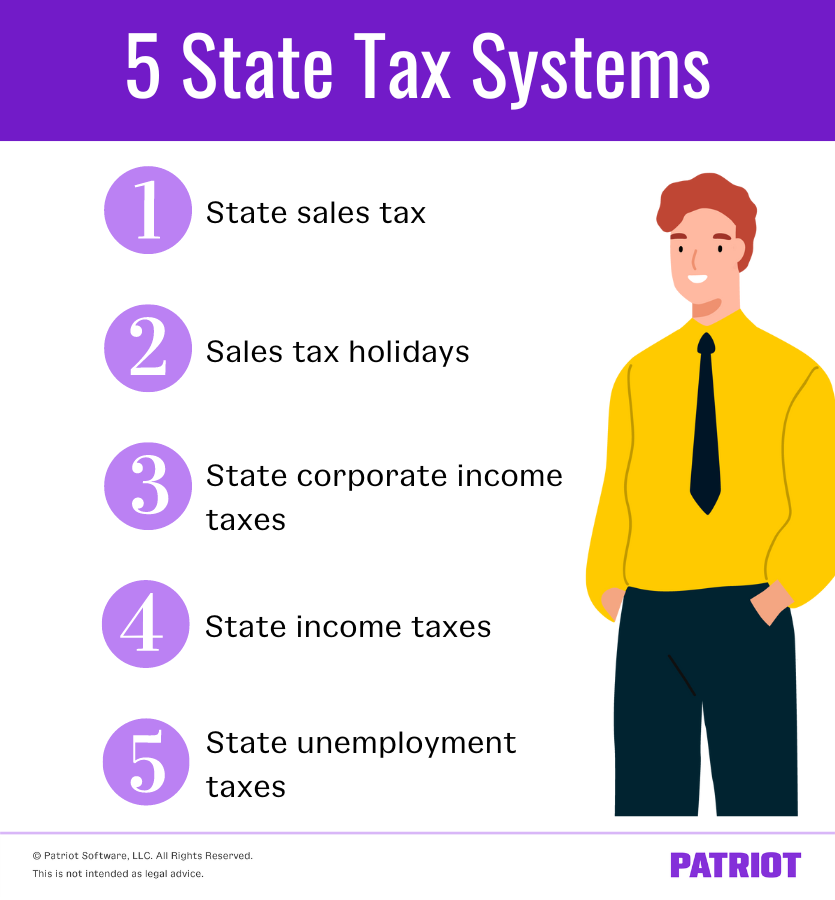If you’re a business owner, employer, or both, you need to know what’s going on in your state. There are many state tax systems that you must follow to remain compliant and avoid penalties.
So, how can you possibly keep up? Brush up on the systems and your responsibilities below.
5 State tax systems
If you want to remain compliant with state laws, you need to know your state tax system. Take a look at five state tax systems.

1. State sales tax
The majority of states have state sales tax. More likely than not, you will come face to face with sales tax and need to know your obligations.
The following states do not have sales tax:
- Alaska
- Delaware
- Montana
- New Hampshire
- Oregon
Hawaii and New Mexico do not have sales tax, either. However, they do impose a general excise tax (GET) and gross receipts tax (GRT) on transactions.
Sales tax is considered a pass-through tax. This means that sales tax passes through to the customers during the point of sale.
Businesses that need to collect sales tax must do so during a sale. Customers are responsible for paying the sales tax in addition to their transaction balance.
Some businesses might also need to charge customers local sales tax. Local sales tax rates can also vary depending on the business location.
Sales tax nexus
In some cases, your business might need to collect sales tax for different states (e.g., online sales), depending on whether you have sales tax nexus. In some states, a business could have sales tax nexus if they have enough of a physical presence.
The following factors can impact sales tax nexus:
- Your office, warehouse, store, or business location
- Employees, contractors, salespeople, or other personnel
- Amount of sales (e.g., $100,000)
- Trade shows or business travel sales
State sales tax rates
Check out the different sales tax rates below. To learn about different sales tax laws by state, contact your state for more information. Keep in mind that you should also check with your state for additional sales tax rates.
| State | 2022 Sales Tax Rate |
|---|---|
| Alabama | 4% |
| Alaska | N/A |
| Arizona | 5.6% |
| Arkansas | 6.5% |
| California | 7.25% |
| Colorado | 2.9% |
| Connecticut | 6.35% |
| Delaware | N/A |
| D.C. | 6% |
| Florida | 6% |
| Georgia | 4% |
| Hawaii | 4% |
| Idaho | 6% |
| Illinois |
6.25% (items required to be titled or registered and general merchandise) 1% (qualifying foods, drugs, and medical appliances) |
| Indiana | 7% |
| Iowa | 6% |
| Kansas | 6.5% |
| Kentucky | 6% |
| Louisiana | 4.45% |
| Maine | 5.5% |
| Maryland | 6% |
| Massachusetts | 6.25% |
| Michigan | 6% |
| Minnesota | 6.875% |
| Mississippi | 7% |
| Missouri | 4.225% |
| Montana | N/A |
| Nebraska | 5.5% |
| Nevada | 6.85% |
| New Hampshire | N/A |
| New Jersey | 6.625% |
| New Mexico | 5.125% |
| New York | 4% |
| North Carolina | 4.75% |
| North Dakota | 5% |
| Ohio | 5.75% |
| Oklahoma | 4.5% |
| Oregon | N/A |
| Pennsylvania | 6% |
| Rhode Island | 7% |
| South Carolina | 6% |
| South Dakota | 4.5% |
| Tennessee | 7% |
| Texas | 6.25% |
| Utah | 4.85% (for the state sales tax rate; the combined rate with local sales tax can be higher) |
| Vermont | 6% |
| Virginia | 4.3% |
| Washington | 6.5% |
| West Virginia | 6% |
| Wisconsin | 5% |
| Wyoming | 4% |
2. Sales tax holidays
A sales tax holiday is a short-term exemption from state sales tax. During sales tax holidays, your business does not collect sales tax from customers.
Sales tax holidays can be:
- A day
- A weekend
- An entire week
Sales tax holiday regulations vary from state to state. The sales tax holiday dates, time-span (e.g., week), eligible items, and maximum amount of a tax-exempt purchase vary by state.
Typically, not all items are tax-exempt during a sales tax holiday. For example, Iowa’s 2022 sales tax holiday only allows clothing up to $100 each to be exempt from sales tax.
Keep in mind that not all states participate in sales tax holidays. And, sales tax holidays are not the same time-span for every state.
The following states have sales tax holidays in 2022:
- Alabama
- Arkansas
- Connecticut
- Florida
- Iowa
- Maryland
- Massachusetts
- Mississippi
- Missouri
- New Mexico
- Ohio
- Oklahoma
- South Carolina
- Tennessee
- Texas
- Virginia
- West Virginia
Check with your state for additional sales tax holiday rules to ensure you’re compliant.
3. State corporate income taxes
If your business is structured as a corporation, you are responsible for paying a corporate tax rate on business earnings. There are both federal and state corporation tax rates.
Not all states levy a corporate tax rate. As of 2022, 44 states levy corporate income taxes. Nevada, Ohio, Texas, and Washington impose a gross receipts tax instead of corporate income taxes.
South Dakota and Wyoming do not have a corporate income or gross receipts tax.
Many states set a state corporate tax rate in addition to the federal rate of 21%. State corporate income tax rates range from 2.5% to 11.5%. Some states apply tax rates based on the corporation’s earnings.
If you’re structured as a corporation, contact your state for more information on state corporate income tax rates and rules.
4. State income taxes
Most states have state income tax. States use income tax to fund state projects and programs, such as education, health care, and public assistance.
If you employ workers in a state with state income tax, you must deduct these taxes from their wages.
There are seven states with no state income tax:
- Alaska
- Florida
- Nevada
- South Dakota
- Texas
- Washington
- Wyoming
New Hampshire and Tennessee only have income tax on dividend and interest income. They do not have income taxes on employment income.
With the majority of states (41 states, plus Washington D.C.) having income tax, it’s important to know your state’s system for income tax withholding.
State income tax rates
Income tax rates are not the same in every state. Like sales tax rates, state income tax rates vary depending on your state.
Some states have a single-rate tax structure, while others have a graduated-rate tax structure. A single-rate structure means one flat tax rate applies to all workers at all pay levels. A graduated-rate structure is when there are different tax rates for multiple income levels.
Eight states use the single-rate method. These states include Colorado, Illinois, Indiana, Massachusetts, Michigan, North Carolina, Pennsylvania, and Utah.
The other 42 states and Washington D.C. use the graduated-rate method. States that use the graduated-rate tax structure have varying tax ranges (e.g., 2% to 5% in Alabama) and can have multiple tax brackets.
5. State unemployment taxes
If you’re an employer, you most likely need to pay state unemployment taxes, or SUTA tax. State unemployment tax might also be referred to as:
- State unemployment insurance (SUI)
- Reemployment taxes (e.g., Florida)
SUTA tax helps fund unemployment programs and pay out benefits to employees who lose their jobs through no fault of their own.
In most cases, state unemployment is an employer-only tax. However, employees in Alaska, New Jersey, and Pennsylvania are subject to state unemployment tax withholding.
Each state sets a different range of tax rates. And, your rate might vary depending on factors like your industry, experience, and employees.
States also set a wage base for unemployment taxes. Once an employee hits the wage base, stop contributing to state unemployment tax.
State unemployment tax rates
As mentioned, rates vary based on a few factors. One of these factors is whether or not you’re a new employer.
Many states issue a standard new employer SUTA tax rate to new employers. These new employer rates vary by state. If your business is in a state that doesn’t use a standard rate, you must wait for your state to assign you a rate.
Rates also vary depending on whether or not your business is in the construction industry. Non-construction companies tend to have lower SUTA rates than construction companies.
For example, new non-construction employers in Ohio usually receive a SUTA rate of 2.7% (2022). New construction employers in Ohio start with a 5.5% SUTA tax rate.
As your business grows and more factors come into play, your rate might increase or decrease.
Check out our new employer states page for more information about SUTA rates by state.
A few other state tax systems…
In addition to the main state tax systems, there are a few you might not be as familiar with. Some of these include:
- Tax and expenditure limits
- State rainy day fund regulations
- Tobacco tax revenue
- State motor fuel tax rates
To find out more about your state’s tax systems, contact your state.
Need a simple way to track your business transactions? Patriot’s online accounting software lets you streamline the way you record your income and expenses. Start your free trial today!
This article has been updated from its original publication date of September 10, 2019.
This is not intended as legal advice; for more information, please click here.



